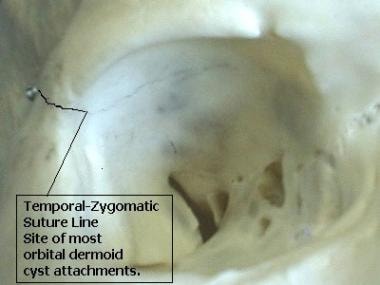Background
Dermoid and epidermoid cysts are examples of choristomas, tumors that originate from aberrant ectodermal tissue. These tumors contain normal-appearing tissue in an abnormal location. As two suture lines of the skull close during embryonic development, dermal or epidermal elements may be pinched off and form cysts. These cysts occur adjacent to a suture line (this is shown in the image below). Approximately 50% of dermoids that involve the head are found in or adjacent to the orbit, either medial or lateral.
Pathophysiology
Orbital dermoid cysts may displace structures in the orbit, causing proptosis, motility abnormalities, or optic nerve compression. Significant displacement may interfere with vision via compression of the optic nerve, causing optic neuropathy, or pressing on extraocular muscles, causing a motility defect, resulting in diplopia. Rupture of the dermoid, either spontaneously or with a trauma, may lead to an intense inflammatory reaction that could mimic orbital cellulitis.
Epidemiology
Frequency
United States
At an ocular oncology center, dermoid tumors were found to comprise 2% of the orbital tumors that came to surgery. [1] Shields et al reported that dermoid cysts comprised of 24% of 645 consecutive orbital biopsies among all age groups and 46% of 250 consecutive biopsies in patients younger than 18 years. [2, 3]
Mortality/Morbidity
Morbidity is usually of a cosmetic nature; occasionally, loss of vision, diplopia, or orbital inflammation may occur. Orbital dermoid cysts almost never cause mortality.
Race
Dermoid tumors show no racial predilection.
Sex
Dermoid tumors have an equal incidence in males and females.
Age
These tumors are most often noted in young children; however, they may appear or grow at any age.
Prognosis
The prognosis of dermoid tumor is excellent with surgical resection. Care must be taken to evaluate the extent of the dermoid (ie, if is it a dumbbell shape around the suture line) in order to avoid cyst rupture, which could lead to a robust inflammatory response.
Patient Education
Patients should understand that these tumors are benign.
Tell patients that surgery generally is successful, but that serious complications can be associated with any orbitotomy (eg, ptosis, diplopia, blindness, death).
-
Temporal-zygomatic suture line on the lateral orbital wall. The location of the periosteal attachment of most orbital dermoids.
-
Orbital dermoid.







